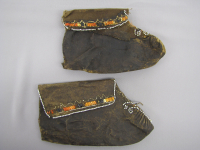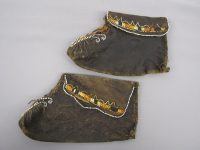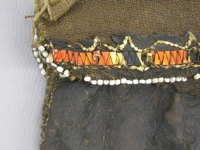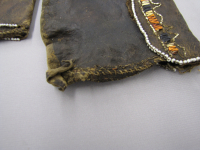moccasins
moccasins
moccasins

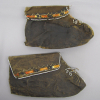
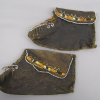
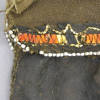
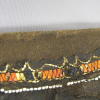
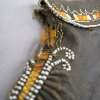
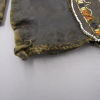

Pair of black dyed moosehide moccasins originally from the collection of the Bibliothèque nationale de France. Worked with porcupine quill and metal cones.
MQB catalogue.
Read More About This Relative
Black dyed moosehide; metal cones; moosehair, red; small white beads; porcupine quill,red, black, white, ivory; vegetable fibre or tendon, coarse cotton thread.
Heel steam is straight, not T shape, and it opens to the sides in two open loops at the end of the seam. Quill wrapping above the cones where they are attached.
Quill work is in zigzag and oversewn line stitches.
This is centre seam construction with the material gathered along the seam, moreso toward the toe. The center panel of zigzag quill covers the seam.
The unfolding spiral motif is made with small white beads.
Repairs have been done, the cotton thread may be the repairs.The moccasins do not look to be the same size, one looks larger than the other.
The collection of the Bibliothèque nationale de France dates from before 1792. Based on style and materials, Autumn Epple believes they date to 1700 - 1750.
Provenance
The ethnographic works from the Bibliothèque Nationale du France are located in the Musée du quai Branly in Paris. These ethnographic works were brought together in this collection at the time of the French Revolution, around 1792. Many of these works came from the Jardin du Roi, the collection of the French kings. In 1792, inventories were made of the possessions of aristocratic French families in Paris and the provinces and many objects were selected to be added to the Bibliothèque Nationale, which was the national collection of the new Republic. Ethnographic material from the Bibliothèque Nationale was located at the Musée d'ethnographie du Trocadéro, then the Musée de l’Homme, and is now in the Musée du quai Branly.
About This GRASAC Record
Unknown artist, moccasins. Currently in the Musée du quai Branly, 71.1878.32.137.1-2. Item photographed and described as part of a GRASAC research trip; GRASAC item id 1390.
This record was created by Anne de Stecher during an RAship for Prof. Ruth Phillips.
The record will be open access on the completion of Anne de Stecher's dissertation, 2011.













Similar materials and techniques to Eastern Great Lakes works with provenance.
 Knowledge Sharing Platform
Knowledge Sharing Platform

